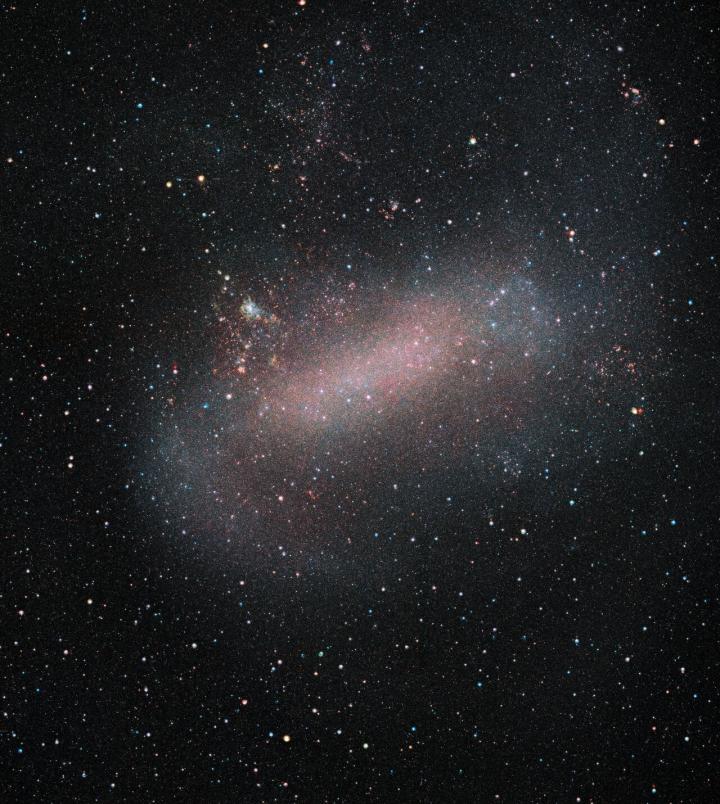
Credit: ESO/VMC Survey
The Large Magellanic Cloud, or LMC, is one of our nearest galactic neighbors, at only 163 000 light years from Earth. With its sibling the Small Magellanic Cloud, these are among the nearest dwarf satellite galaxies to the Milky Way. The LMC is also the home of various stellar conglomerates and is an ideal laboratory for astronomers to study the processes that shape galaxies.
ESO’s VISTA telescope, has been observing these two galaxies for the last decade. The image presented today is the result of one of the many surveys that astronomers have performed with this telescope. The main goal of the VISTA Magellanic Clouds (VMC) Survey has been to map the star formation history of the Large and Small Magellanic Clouds, as well as their three-dimensional structures.
VISTA was key to this image because it observes the sky in near-infrared wavelengths of light. This allows it to see through clouds of dust that obscure parts of the galaxy. These clouds block a large portion of visible light but are transparent at the longer wavelengths VISTA was built to observe. As a result, many more of the individual stars populating the centre of the galaxy are clearly visible. Astronomers analysed about 10 million individual stars in the Large Magellanic Cloud in detail and determined their ages using cutting-edge stellar models[1]. They found that younger stars trace multiple spiral arms in this galaxy.
For millennia, the Magellanic Clouds have fascinated people in the Southern Hemisphere, but they were largely unknown to Europeans until the Age of Discovery. The name we use today harkens back to the explorer Ferdinand Magellan, who 500 years ago began the first circumnavigation of the Earth. The records the expedition brought back to Europe revealed many places and things to Europeans for the first time. The spirit of exploration and discovery is ever more live today in the work of astronomers around the world, including the VMC Survey team whose observations led to this stunning image of the LMC.
###
Notes
[1] Stellar models allow astronomers to predict the life and death of stars, providing insights into properties like their ages, mass, and temperature.
More information
The stars revealed by this image were discussed in the paper “The VMC Survey – XXXIV. Morphology of Stellar Populations in the Magellanic Clouds” to appear in the journal Monthly Notices of the Royal Astronomical Society.
ESO is the foremost intergovernmental astronomy organisation in Europe and the world’s most productive ground-based astronomical observatory by far. It has 16 Member States: Austria, Belgium, the Czech Republic, Denmark, France, Finland, Germany, Ireland, Italy, the Netherlands, Poland, Portugal, Spain, Sweden, Switzerland and the United Kingdom, along with the host state of Chile and with Australia as a Strategic Partner. ESO carries out an ambitious programme focused on the design, construction and operation of powerful ground-based observing facilities enabling astronomers to make important scientific discoveries. ESO also plays a leading role in promoting and organising cooperation in astronomical research. ESO operates three unique world-class observing sites in Chile: La Silla, Paranal and Chajnantor. At Paranal, ESO operates the Very Large Telescope and its world-leading Very Large Telescope Interferometer as well as two survey telescopes, VISTA working in the infrared and the visible-light VLT Survey Telescope. Also at Paranal ESO will host and operate the Cherenkov Telescope Array South, the world’s largest and most sensitive gamma-ray observatory. ESO is also a major partner in two facilities on Chajnantor, APEX and ALMA, the largest astronomical project in existence. And on Cerro Armazones, close to Paranal, ESO is building the 39-metre Extremely Large Telescope, the ELT, which will become “the world’s biggest eye on the sky”.
Links
- Research paper – https:/
/ www. eso. org/ public/ archives/ releases/ sciencepapers/ eso1914/ eso1914a. pdf - Photos of VISTA – http://www.
eso. org/ public/ images/ archive/ category/ surveytelescopes/
Contacts
Maria-Rosa Cioni
Leibniz-Institut für Astrophysik Potsdam (AIP)
Potsdam, Germany
Tel: +49 331 7499 651
Email: [email protected]
Mariya Lyubenova
ESO Head of Media Relations
Garching bei München, Germany
Tel: +49 89 3200 6188
Email: [email protected]
Media Contact
Calum Turner
[email protected]
Original Source
http://www.




